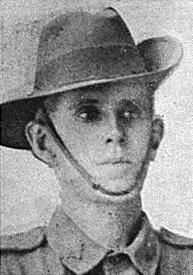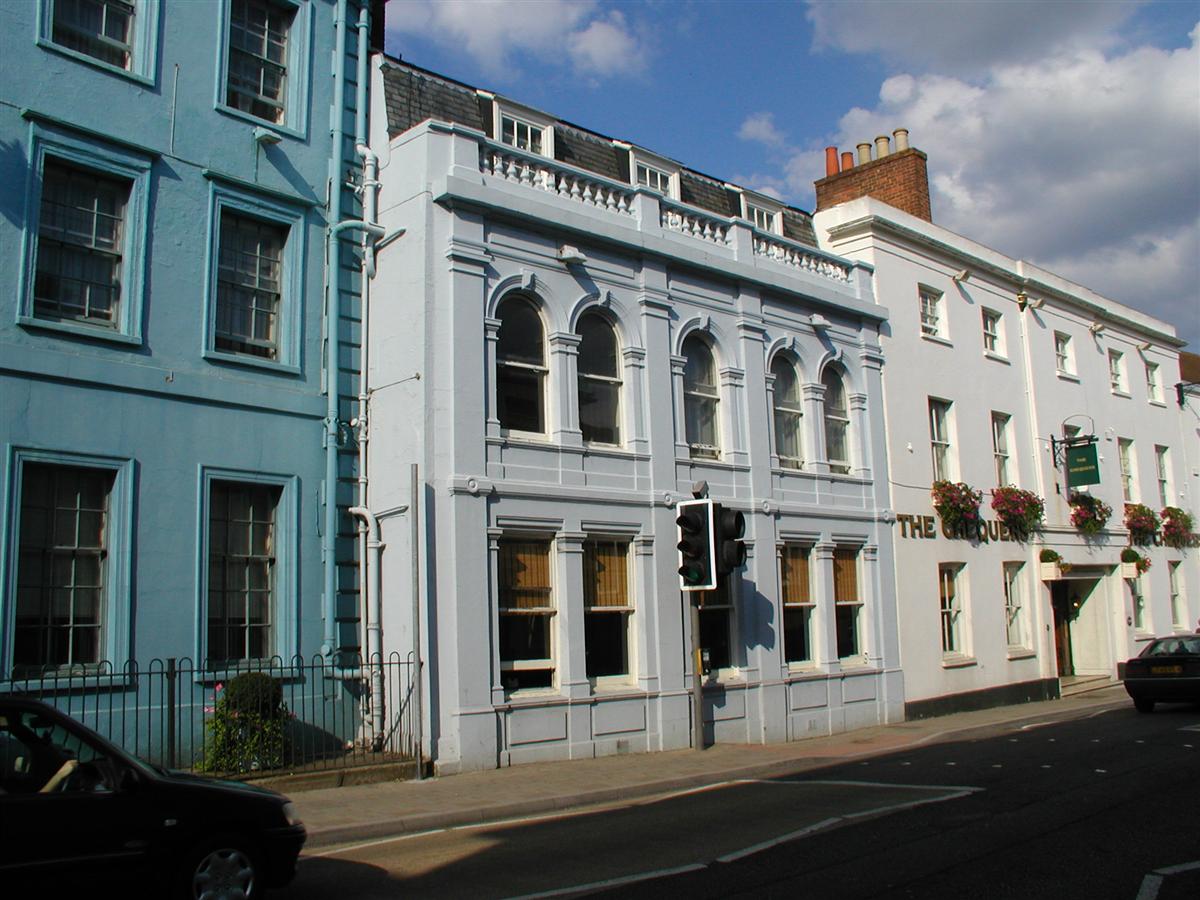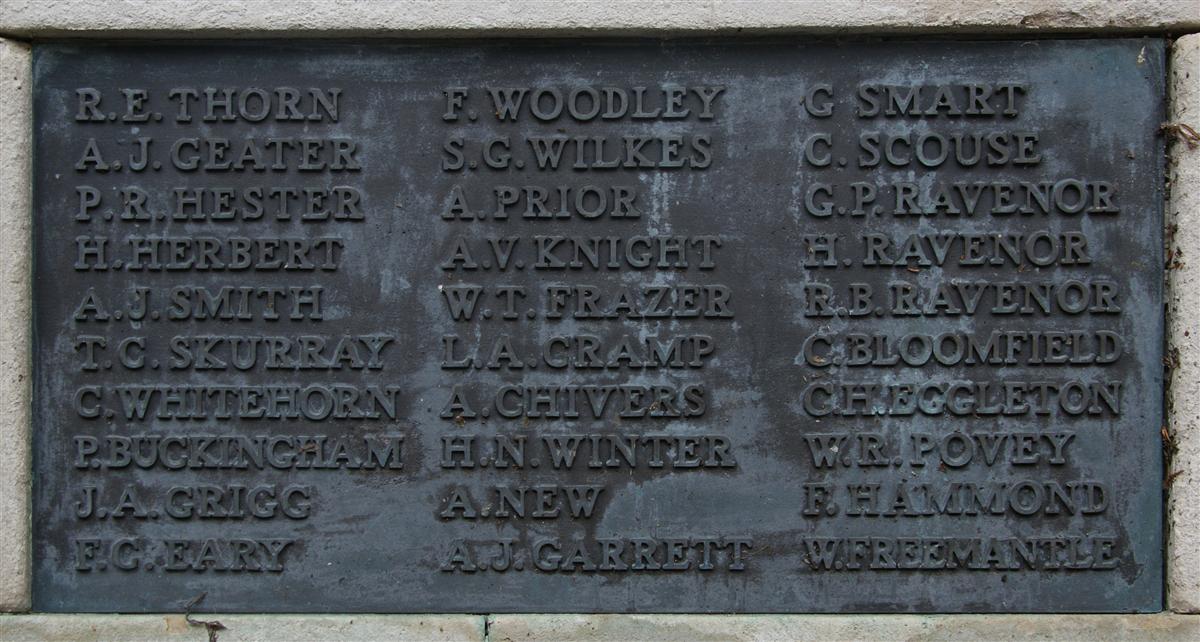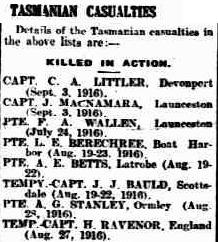Herbert Ravenor
Private Herbert Ravenor, 6th Battalion, Australian Infantry Force

Herbert Ravenor |
Herbert was born in March 1872, the son of Richard Ravenor and his wife Charlotte née Bland. His father is often shown as a plumber but this was not the man who would turn up to fix the tap; his business was indeed plumbing and associated work but it was as the owner/manager of a significant business.
The family home on Oxford Street in the Speenhamland area of Newbury was a very substantial residence, around 1935 it was purchased by Trust Houses and incorporated into the Chequers Hotel next door. The Speenhamland area of Newbury is famous/infamous for the C18th income support scheme known as the Speenhamland System because it was put together at a meeting of Berkshire JPs in a Speenhamland inn 50 yards from the Ravenors’ house.
Until 1878 Speenhamland was not part of the Borough of Newbury; in that year boundary changes saw it incorporated into the Borough. Part of the process was to add representatives of Speenhamland to the Borough Council – Richard Ravenor was one of those elected. By the time of the Great War Alderman Ravenor was the ‘father’ of the council, the oldest and longest serving councillor. Herbert was the eldest of Richard and Charlotte’s seven sons; their only sister, Alice, must have felt a little isolated at times!

The Ravenor family home, now part of the Chequers Hotel |
When war broke out he did not enlist immediately, but, as it became apparent that this was not a short war that would be over by Christmas, he decided he should do his bit. So he travelled to Hobart and, on 5 January 1915 he enlisted in the infantry, giving his occupation as ‘orchardist’ – he was 42 years 10 months old. Standing 5ft 7¾in tall he weighed 8st 13lb had a medium complexion, grey eyes and ‘greyish black’ hair.
On 19 February 1915 he boarded HMAT Runic at Melbourne bound for Egypt, where he would have received some training before being sent to join his battalion at Gallipoli. He arrived at his battalion on 8 May 1915. Three weeks later he was wounded, shot in the shoulder, which resulted in his being evacuated on the hospital ship Neuralia to Malta where he was admitted into hospital on 12 June. After a couple of months he was shipped back to England on the Ascanius, arriving on 15 December at the 3rd London General Hospital in Wandsworth on 15 September.
Newbury Weekly News, 24 June 1915 – Local War Notes
Pte Herbert Ravenor, of the Australian Expeditionary Force, and son of Alderman Richard Ravenor, is now in hospital in Malta, from the effects of a shot wound in the shoulder, and is progressing favourably.
His shoulder took several months to heal some of which time he spent convalescing in Weymouth where the AIF had a convalescence/training camp called Monte Video. Eventually he was cleared for duty and returned to his battalion, which had just arrived in France, joining them on 11 August 1916. The battalion had just come out of the line, where they had faced the Germans for the first time as they made a last counter-attack attempting to push back the Allies from recently captured positions as the phase of the Battle of the Somme, known as the Battle of Pozieres came to a end. Herbert was soon promoted to Lance Corporal (20 August) and immediately given further advancement to the temporary rank of Corporal. For a man with little more than a month’s experience at any front this was a mark of the man; had he survived a man of his education and life experience may well have been put forward for a commission. However, this was not to be, only a week later, as he was going forward with the battalion to relieve the 23rd Battalion AIF in trenches near Pozieres, a shell exploded killing him and four others.
The news reached Newbury a few weeks later:
Newbury Weekly News, 21 Sep 1916 – Local War Notes
Townspeople have been greatly saddened by news of the death of Corporal Herbert Ravenor, eldest son of Richard Ravenor, of Oxford-street. The intimation was unofficially conveyed in a letter received by the father, from a comrade, who writing on September 10th said:- “It is with deep regret that I have to inform you that your son, Corporal Ravenor, was killed in action a fortnight ago, August 27th. He joined the battalion on the 14th August, and on our way up to the trenches on the 27th a shell killed him and four others instantaneously. He was in charge of a section, and had just been given extra stripe. All our section were very much attached to him, and we all join in sending our heartfelt sympathy to you in your loss.

Herbert's name on Newbury War Memorial, between those of his brothers Geoffrey and Richard. (right) |
Herbert Ravenor was a fine manly fellow, and his wide experience of men and manners in different parts of the Empire, had broadened his views, and induced him to become a serious thinker. His death has been a source of great grief to many old Newburians with whom he was contemporary, and much sympathy is extended to his father and other members of the family. Three sons are on war service, Cyril, who was in the Mercantile Marine, exchanged into the Royal Navy; Geoffrey, who served in France with the Royal Fusiliers, is now a second-lieutenant in the Royal Berks, and again in France. Maurice, who was formerly in the Borough Surveyor’s Office, is now engaged in submarine work for the Government.

'Captain' Herbert Ravenor |
Herbert's body lies in the Pozieres BritishCemetery Pozieres British Cemetery, an impressive cemetery lying alongside the Albert-Bapaume road south of the village of Pozieres. Surrounding the cemetery is the Pozieres memorial.
Herbert and his brothers were commemorated in an unusual In Memoriam announcement in the local paper:
Newbury Weekly News, 11 September 1919 – In Memoriam
They Whom this Scroll Commemorates were numbered among those who, at the call of King and country, left all that was dear to them, endured hardness, faced danger, and finally passed out of the sight of men by the path of duty and self-sacrifice, giving up their own lives that others might live in freedom.
“Let those who come after see to it that their names be not forgotten.”
2nd Lieut GEOFFREY PAXTON RAVENOR, Killed in France – Royal Berks Regiment.
HERBERT RAVENOR, 15th Batt Australian Infantry, Killed in France.
RICHARD BLAND RAVENOR, attached Royal Australian Navy, drowned at sea.
Locally Herbert is remembered on Newbury's Town War Memorial and a roll of honour at St Bartholomew's school, Newbury.
His name was also included on the gravestone over his mother's grave in Speen churchyard. Sadly the stone broke, or was broken, and over time clear-ups in the churchyard have removed all trace of the grave. Fortunately a photograph was taken of the broken stone before it disappeared, so much of the inscription has been recorded for posterity:
They whom this stone commemorate |
Four of his brothers served the Empire; one, Geoffrey Paxton Ravenor, his youngest brother and a Lieutenant with the Royal Berks, died soon after Herbert; another, Richard Bland Ravenor, died in the harbour of Shortland Island, on of the Solomon Islands, reportedly while attached to the Royal Australian Navy. A first cousin, Alexander Mitchelson Ravenor also died serving with the Royal Berks and two more distant cousins, Percy Richard Ravenor [Percy Richard Ravenor] and Hubert Arthur Ravenor also died. Indeed, these are all the Ravenors recorded in the Commonwealth War Graves Commission’s Debt of Honour register demonstrating that this is a rarel surname.
A further death occurred in the family when Herbert’s father, Richard, died on 10 March 1917; a death that was thought to have been accelerated by the grief of losing his sons within the past year. Unusually for the time the Alderman's body was cremated and his ashes were interred in his wife's grave (the first interment of ashes in Speen churchyard).
After his death Herbert’s financial affairs were in the hands of his executors, his brothers Arthur and Maurice; a complicated estate to wind up as much of his wealth was in the Tasmanian fruit farm. His UK estate was valued at almost £2,000 (up to £500,000 in today’s terms)– showing again that the Ravenors were not your average plumbers.
